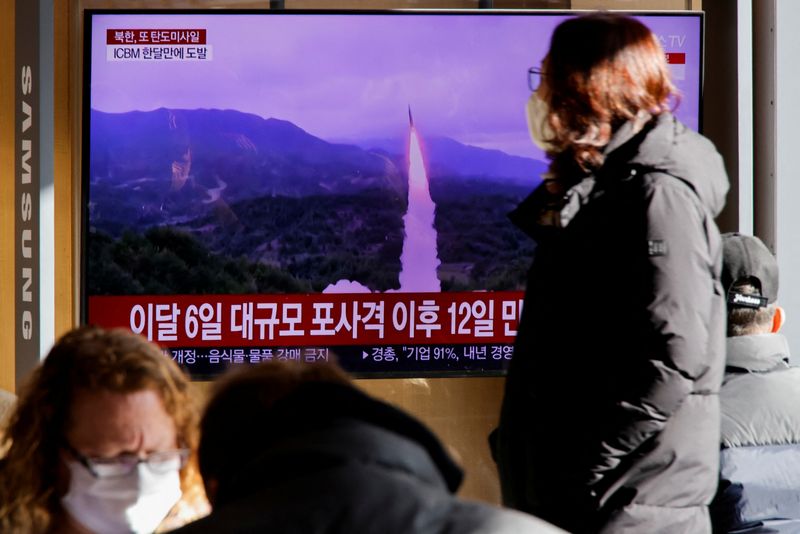By Hyonhee Shin
SEOUL (Reuters) -North Korea's state media KCNA said on Monday the country conducted an "important, final phase" test on Sunday for the development of a spy satellite, which it seeks to complete by April 2023.
The report was released a day after the South Korean and Japanese militaries reported the isolated North's launch of two intermediate-range ballistic missiles towards its east coast.
Pyongyang's National Aerospace Development Administration (NADA) conducted the test at its Sohae satellite launching station in the northwest to review its capability of satellite imaging, data transmission and ground control systems, according to KCNA.
A vehicle carrying a mock satellite, which also included a 20 metre resolution full-colour camera, two multi-spectra cameras, image transmitters and receivers, a control device and a storage battery, was fired at the "lofted angle" of 500 km (311 miles).
"We confirmed important technical indicators such as camera operating technology in the space environment, data processing and transmission ability of the communication devices, tracking and control accuracy of the ground control system," a NADA spokesperson said in the KCNA dispatch.
The spokesperson called the test a "final gateway process of launching a reconnaissance satellite" which will be completed by April.
SATELLITE PHOTOS
KCNA also released two black-and-white, low-resolution images of the South Korean capital Seoul and nearby port city of Incheon, which it said were taken during Sunday's launch.
Martyn Williams, a fellow at the Washington-based Stimson Center, said the North's camera cannot perform usual imaging functions carried out by modern commercial satellites he would use for the 38 North project, which offer images at 50 cm or even 30 cm.
"At 20 m resolution, the satellite will be able to make out buildings, ships and aircraft but not vehicles, people or other machinery," he said.
"It's very coarse and isn't really useful for making any determination on what's happening on the ground."
Shin Jong-woo, a senior researcher at the Korea Defense & Security Forum, raised doubt over other KCNA photos from the launch scene, which showed an old missile carrying cameras, not a satellite.
"You don't want to bring an antiquated missile for such an important programme as satellite and spate development," he said.
Shin said the release of the satellite photos and the missile launch could be intended to threaten Seoul and Tokyo.
Williams also said the missile was unlikely to have put the satellite into orbit, but the launch might be aimed at testing and verifying technology such as the ability to take images at a certain time and send data back to earth.
"Even if it is crude, North Korea has demonstrated with its other programs a continual advancement in technology so what they do now will likely be improved in coming years," Williams said.
North Korea has conducted an unprecedented number of missile tests this year, including an intercontinental ballistic missile (ICBM) designed to reach the U.S. mainland, in defiance of international sanctions.
On Thursday, the North tested a high-thrust solid-fuel engine which experts said would facilitate quicker and more mobile launch of ballistic missiles, as it seeks to develop a new strategic weapon and speed up its nuclear and missile programmes.

Pyongyang has tested satellite systems during several rocket launches, and leader Kim Jong Un has said its pursuit of a spy satellite is meant to provide real-time information on military actions by the United States and its allies.
South Korea's presidential office strongly condemned the North's latest launch, saying its continued provocations and nuclear and missile development would only endanger its own regime.